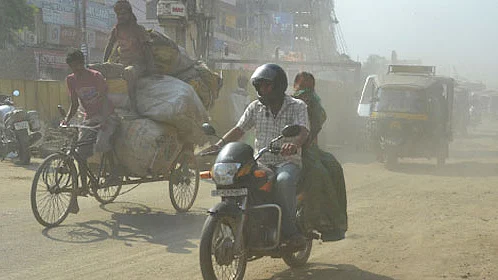Air quality ‘severe’ in cities across north and central India after Diwali
Faridabad recorded average AQI reaching 455, followed by Noida with an AQI of 432. Lucknow, Patna and Ghaziabad recorded “severe” air with the AQI at 412, 427 and 422, respectively

Seven cities, in north and central India, experienced “poor” to “severe” air quality on the day after Diwali, according to government data.
Seven cities, including Noida, Faridabad, Patna and Lucknow, recorded worse air than Delhi, according to the Air Quality Index (AQI) bulletin, which records a 24-hour average released by the Central Pollution Control Board (CPCB). AQI is a number used by governments to communicate to the public how polluted the air is. AQI of 100 is considered acceptable in India.
An analysis of the air quality of Patna and Lucknow and other cities on Diwali night and the day after, by the Centre for Environment and Energy Development (CEED), indicated an extremely poor situation where air quality in Patna was the third worst, after Faridabad and Noida in India.
Bad air quality was witnessed despite the cracker ban imposed by the apex court. Be-sides, calm winds and a high level of moisture in the air further deteriorated the air quality of Patna
CEED tracked the four-hour average PM2.5 data of November 7, 8, 2018, from the air quality monitoring station of the State Pollution Control Board to track the changes in air quality during Diwali.
On Diwali night and the morning after Diwali, Patna experienced severe and emergency levels of pollution. The PM2.5 level was low during the day of Diwali (12 PM - 4 PM) and after 4 PM, it started increasing and reached its peak. 144 mg/m³ was the 4 hr-average and it was PM 2.5 concentration during day-time (12 PM- 4 PM) on Diwali and it increased to 700 mg/m³ between 8 PM to 12 AM. In the midnight (12 AM - 4 AM), the PM 2.5 level increased to an alarming level, which is a direct indicator of bursting crackers on Diwali.
According to data released by CEED for Lucknow, on Diwali night and the morning after Diwali, the city experienced severe and emergency levels of pollution. The PM2.5 level was low during the day of Diwali (12 PM - 4 PM) and after 4 PM, it started increasing and reached its peak. 169 mg/m³ was the 4 hr-average PM2.5 concentration during day-time (12 PM- 4 PM) on Diwali and it increased to 694 mg/m³ between 8 PM to 12 AM. In the midnight (12 AM- 4 AM), the PM 2.5level increased to an alarming level, which is a direct indicator of the impact of bursting crackers on Diwali. It increased to 834 mg/m³.
Faridabad recorded average AQI reaching 455, followed by Noida with an AQI of 432. Lucknow, Patna and Ghaziabad recorded “severe” air with the AQI at 412, 427 and 422, respectively.
Bad air quality was witnessed despite the cracker ban imposed by the apex court. Be-sides, calm winds and a high level of moisture in the air further deteriorated the air quality of Patna.
Rampati Kumar, founder and CEO of CEED said, “People have been bursting firecrackers on Diwali for years now, but background pollution was not as serious as it is today. Today we are already breathing unhealthy air and every firecracker burst during Diwali adds to the existing heavy pollution load. The court’s decision was meant for our well-being and if we do not abide by it, then it is disappointing”.
“We urge to the government to issue a public health advisory and to formulate an emergency action plan for Patna and Lucknow,” said Rampati Kumari of CEED.
Follow us on: Facebook, Twitter, Google News, Instagram
Join our official telegram channel (@nationalherald) and stay updated with the latest headlines
